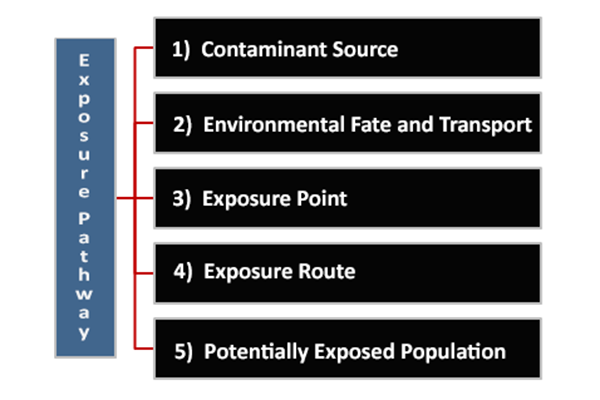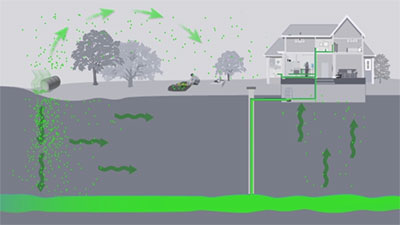Overview of the Exposure Pathway Evaluation
This section provides an overview of the exposure pathway evaluation, the first of four scientific evaluations health assessors conduct during the PHA process.
The goal of the exposure pathway evaluation is to identify likely past, present, and future site-specific exposure situations. To pinpoint the exposure pathways associated with a site, health assessors will answer these questions:
- Are there people who were, are, or could be exposed to contaminants from the site?
- Under what conditions did, does, or could exposure occur?
- When were people exposed (past, present, future)?
The exposure pathway evaluation is the first of four scientific evaluations conducted during the PHA process. The other three scientific evaluations that come after the exposure pathway evaluation follow in this order:
This order of the four scientific evaluations in the PHA process is logical because extensive scientific evaluations are not necessary if people are not coming into contact with environmental contamination. Furthermore, exposure pathway evaluations inform the other scientific evaluations.
An exposure pathway is the link between an environmental release or source to the point where a population might come into contact with, or be exposed to, the environmental contaminant.
Exposed means that a person contacted, swallowed, or breathed in a contaminant. Being exposed doesn’t mean that a person will get sick. Whether a person will get sick depends on many factors:
- Properties and toxicity of the contaminant
- Concentration of the contaminant
- Duration and frequency of exposure
- Route of exposure
- Age, genetics, and health of the person
Note: This e-manual covers the topic of selecting the sampling data prior to this section on exposure pathways. But in your documents, health assessors can conceptualize the exposure pathways first, then present the data with an understanding of the completed and potential pathways.
Every site presents unique challenges and exposure scenarios. Health assessors need to consider site-specific factors that might enhance, prevent, or modify exposures to environmental contamination, and use exposure pathways to evaluate the ways in which people might come into contact with that contamination. Specifically, health assessors need to examine the following five elements:
Tip: Be sure to consider past, current, and future exposure conditions because the elements of the exposure pathway typically change with time.
- Contaminant source: Where did the contaminants come from?
- Environmental fate and transport: How contaminants released to the environment move through and across different media, as well as how they degrade or transform in the environment.
- Exposure point: The specific location(s) where people might come into contact with a contaminated medium.
- Exposure route: The path by which contaminants enter the body (dermal, inhalation, ingestion).
- Potentially exposed population: The people who potentially have, do, or could come in contact with environmental contaminants.

These five elements largely determine the extent to which exposures have occurred, are occurring, or could occur at and around a site. Though some can require more detailed evaluations than others, reviewing these elements will help you identify exposures that require further investigation during the PHA process.

Learn more about the five elements of the exposure pathway in this animated video.
Various exposure assessment tools are available to help determine if exposures are possible and to identify potentially exposed populations. Examples of exposure assessment tools are included for reference in the PHAGM Toolbox. Whether a particular exposure assessment tool applies will vary based on site-specific exposure conditions.